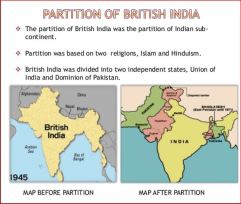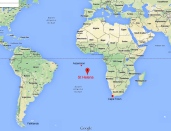.
“In the 1790s the British Government was the largest purchaser of captured Africans."...“Britain dispatched about 10,000 voyages to Africa for slaves” over 245 years from 1562. 70% of UK government’s total income came from taxes on goods from its colonies between 1750 and 1780.…"Caribbean islands became the hub of the British Empire. The sugar colonies were Britain’s most valuable colonies.”
"Gandhi and other nationalist leaders...organized the nonviolent “Quit India” campaign to hasten the British departure. British colonial authorities responded by jailing Gandhi and hundreds of others."
In 1947 the British Empire carved Pakistan out of India and told both they were now free. The resulting religious turmoil in India and Pakistan caused deaths of hundreds of thousands, including Gandhi, who was assassinated. British imperialists had effectively hog-tied India in a way guaranteed to cause maximum misery and genocidal volumes of deaths.…[Map, partition of British India in 1947]
……………………………
“East India Company,” also known as English East India Company, was incorporated by royal charter in 1600. “Large-scale transportation of slaves by the company was prevalent from the 1730s....Although some of those enslaved by the company came from Indonesia and West Africa, the majority came from East Africa:”
 [A British slave destination, Saint Helena Island near Africa]
[A British slave destination, Saint Helena Island near Africa]
“Beginning in the early 1620s, the East India Company began using slave labour and transporting enslaved people to its facilities in Southeast Asia and India as well as to the island of St. Helena in the Atlantic Ocean, west of Angola. Although some of those enslaved by the company came from Indonesia and West Africa, the majority came from East Africa—from Mozambique or especially from Madagascar—and were primarily transported to the company’s holdings in India and Indonesia. Large-scale transportation of slaves by the company was prevalent from the 1730s to the early 1750s and ended in the 1770s….
Beginning in the early 19th century, the company financed the tea trade with illegal opium exports to China. Chinese opposition to that trade precipitated the first Opium War (1839–42), which resulted in a Chinese defeat and the expansion of British trading privileges; a second conflict, often called the Arrow War (1856–60), brought increased trading rights for Europeans….
East India Company, also called English East India Company, formally (1600–1708) Governor and Company of Merchants of London Trading into the East Indies or (1708–1873) United Company of Merchants of England Trading to the East Indies, English company formed for the exploitation of trade with East and Southeast Asia and India, incorporated by royal charter on December 31, 1600. Starting as a monopolistic trading body, the company became involved in politics and acted as an agent of British imperialism in India from the early 18th century to the mid-19th century. In addition, the activities of the company in China in the 19th century served as a catalyst for the expansion of British influence there….
From 1834 it was merely a managing agency for the British government of India….[In 1873 the British government assumed direct rule of India so East India Company dissolved as a legal entity].
Indian Mutiny
Indian Mutiny, also called Sepoy Mutiny or First War of Independence, widespread but unsuccessful rebellion against British rule in India in 1857–59. Begun in Meerut by Indian troops (sepoys) in the service of the British East India Company, it spread to Delhi, Agra, Kanpur, and Lucknow. In India it is often called the First War of Independence and other similar names.
Background
To regard the rebellion merely as a sepoy mutiny is to underestimate the root causes leading to it. British paramountcy-i.e., the belief in British dominance in Indian political, economic, and cultural life-had been introduced in India about 1820. The British increasingly used a variety of tactics to usurp control of the Hindu princely states that were under what were called subsidiary alliances with the British. Everywhere the old Indian aristocracy was being replaced by British officials….
Hindu society was being affected by the introduction of Western ideas. Missionaries were challenging the religious beliefs of the Hindus….
Converts to Christianity were to share with their Hindu relatives in the property of the family estate. There was a widespread belief that the British aimed at breaking down the caste system. The introduction of Western methods of education was a direct challenge to orthodoxy, both Hindu and Muslim….
Aftermath [of the Indian rebellion]
The immediate result of the [1857-58] mutiny was a general housecleaning of the Indian administration. The East India Company was abolished in favour of the direct rule of India by the British government. In concrete terms, this did not mean much, but it introduced a more personal note into the government and removed the unimaginative commercialism that had lingered in the Court of Directors….
Another significant result of the mutiny was the beginning of the policy of consultation with Indians. The Legislative Council of 1853 had contained only Europeans and had arrogantly behaved as if it were a full-fledged parliament. It was widely felt that a lack of communication with Indian opinion had helped to precipitate the crisis. Accordingly, the new council of 1861 was given an Indian-nominated element….
Finally, there was the effect of the mutiny on the people of India themselves. Traditional society had made its protest against the incoming alien influences, and it had failed. The princes and other natural leaders had either held aloof from the mutiny or had proved, for the most part, incompetent. From this time all serious hope of a revival of the past or an exclusion of the West diminished….
Saint Helena Island [As of 2021, “The legislature of St. Helena consists of the British monarch…The territory’s residents are British subjects.”]
“The Dutch may have occupied St. Helena about 1645–51, but in 1659 the English East India Company took possession of the island. After a brief Dutch occupation in 1673, the East India Company was confirmed in its ownership. By 1673 nearly half of the inhabitants were imported slaves, but between 1826 and 1836 all slaves were freed. The remoteness of St. Helena made it attractive to the powers of Europe as a place of exile for Napoleon I, and he was confined at Longwood House on the island from October 1815 until his death in May 1821. During that period the island was placed under the jurisdiction of the British crown. Subsequently the East India Company resumed control until 1834, when the authority of the crown was restored. St. Helena remained reasonably prosperous as a busy port of call until about 1870; thereafter steam started replacing sail in seafaring, and the Suez Canal opened (1869), changing the pattern of sea routes….
St. Helena was given some measure of self-rule through an Order in Council and Royal Instructions in 1966 (effective January 1967) that provided for local executive and legislative councils; this order was replaced by a new constitution that became effective in January 1989. The territory’s relationship with Great Britain continued to evolve, and in July 2009 both parties approved a new constitution that came into effect on September 1. It included a bill of rights and limited some of the powers of the governor while giving more authority to members of the elected councils.”…
“The Indian Independence Movement,” 1857-1947
“British rule in India began in 1757 when, following the British victory at the Battle of Plassey, the English East India Company began exercising control over the country. The East India Company ruled India for 100 years, until it was replaced by direct British rule (often referred to as the British raj) in the wake of the Indian Mutiny in 1857–58. The Indian independence movement began during World War I and was led by Mohandas K. Gandhi, who advocated for a peaceful and nonviolent end to British rule.”…
“He [Ghandi] got the natives to embrace their Indian culture, a thing that nobody had accomplished before him. Gandhi told the Indians that despite their differences, they all shared one very important thing: a common hatred of the British. He formed a collective identity in India that had never been present in the country before….He was one of the most important factors that accounted for the eventual triumph of the Indians over the British.”…
“India and Pakistan win independence,” History.com
 [Map, partition of British India in 1947]
[Map, partition of British India in 1947]
The British would only grant independence to India if it agreed to give up some of its land to a new country, Pakistan. “On August 15, 1947, the Indian Independence Bill took effect, inaugurating a period of religious turmoil in India and Pakistan that would result in the deaths of hundreds of thousands, including Gandhi, who was assassinated by a Hindu fanatic in January 1948 during a prayer vigil to an area of Muslim-Hindu violence….Hundreds of people were killed in the first few days after independence...in the northern province of Punjab, which was sharply divided between Hindu-dominated India and Muslim-dominated Pakistan….
After World War I Gandhi organized the first of his many effective passive-resistance campaigns in protest of Britain’s oppressive rule in India. In the 1930s, the British government made some concessions to the Indian nationalists, but during World War II discontent with British rule had grown to such a degree that Britain feared losing India to the Axis.
Gandhi and other nationalist leaders rejected as empty the British promises of Indian self-government after the war and organized the nonviolent “Quit India” campaign to hasten the British departure. British colonial authorities
responded by jailing Gandhi and hundreds of others….
In 1947 the Indian National Congress reluctantly accepted the creation of Pakistan to appease the Muslim League and conclude the independence negotiations.”…
………………………
.............


No comments:
Post a Comment